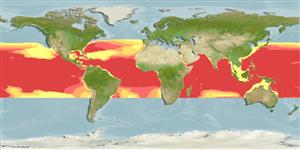Common names from other countries
>
Myctophiformes (Lanternfishes) >
Myctophidae (Lanternfishes) > Diaphinae
Etymology: Diaphus: Greek, dis, dia = through + Greek, physa, phyo = to beget, to have as offspring (Ref. 45335).
Environment: milieu / climate zone / depth range / distribution range
Ecologia
marinhas batipelágico; oceanódromo (Ref. 51243); intervalo de profundidade 0 - 8000 m (Ref. 58018). Deep-water; 43°N - 27°S
Eastern Atlantic: between 30°N and about 19°N and between 7°N and 11°S (uncommon over the Mauritanian Upwelling Region). Western Atlantic: USA in the Gulf Stream to Brazil. Indian Ocean: 7°N and 23°S; Agulhas Current (Ref. 4066). Western Pacific: to 35°N in Kuroshio and Tushima currents. Eastern Pacific: 8° and 12°S.
Comprimento de primeira maturação / Tamanho / Peso / Idade
Maturity: Lm 7.1, range 5 - 7.7 cm
Max length : 9.0 cm SL macho/indeterminado; (Ref. 4479)
Espinhos dorsais (total) : 0; Raios dorsais (total) : 14 - 15; Espinhos anais: 0; Raios anais : 16 - 17.
Oceanic and mesopelagic, found between 375-750 m during the day; between 40-225 m at night (maximum abundance at 100 m depth) (Ref. 4479).
Ciclo de vida ou comportamento de acasalamento
Maturities | Reprodução | Spawnings | Egg(s) | Fecundities | Larvas
Hulley, P.A., 1990. Myctophidae. p. 398-467. In J.C. Quero, J.C. Hureau, C. Karrer, A. Post and L. Saldanha (eds.) Check-list of the fishes of the eastern tropical Atlantic (CLOFETA). JNICT, Lisbon; SEI; Paris; and UNESCO, Paris. Vol. 1. (Ref. 4479)
Status na Lista Vermelha da UICN (Ref. 130435)
CITES (Ref. 128078)
Not Evaluated
Ameaça para os humanos
Harmless
Uso pelos humanos
Ferramentas
Relatórios especiais
Baixar XML
Fontes da internet
Estimates based on models
Preferred temperature (Ref.
115969): 1.7 - 4.3, mean 2.3 (based on 6168 cells).
Índice de diversidade filogenética (Ref.
82804): PD
50 = 0.5000 [Uniqueness, from 0.5 = low to 2.0 = high].
Bayesian length-weight: a=0.00813 (0.00444 - 0.01488), b=3.06 (2.90 - 3.22), in cm Total Length, based on LWR estimates for this species & Genus-body shape (Ref.
93245).
Nível Trófico (Ref.
69278): 3.0 ±0.00 se; based on food items.
Resiliência (Ref.
120179): Elevada, tempo mínimo de duplicação da população menor que 15 meses (Preliminary K or Fecundity.).
Fishing Vulnerability (Ref.
59153): Low vulnerability (10 of 100).
